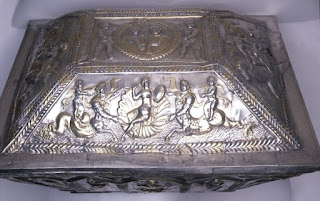Can you spot the differences? The reconstruction of Constantine the Great (325 CE, right) and the Statue of Jupiter (ca 100 CE, below) were made nearly 200 year apart, but they look so similar!
In actuality, the similarities are not coincidence. Constantine (the guy looking all cool above right) removed the statue of Jupiter from Olympia and brought it to Constantinople because it was so famous. He then made his statue (Constantine the Great) and modeled it after the king of the Gods. The main differences in them, however, show Constantine as a Christian emperor, not a pagan one. Constantine's statue holds and orb topped with a cross. What he is doing is really clever. He is linking himself to Jupiter, the Roman king of the Gods, but also to Christ, King of heaven. Way to play both sides of the field!
These statues are just two examples of how Byzantines in Constantinople and around the world used common visual language like that of Greco-Roman statues to show how cool their new Christian rule was. And they say they hated pagans... Ha!
Images courtesy of Wikimedia







